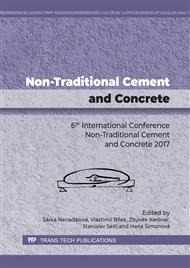p.69
p.73
p.79
p.83
p.87
p.92
p.96
p.103
p.111
Physico-Mechanical Properties and Durability Aspects of Alkali-Activated Calcareous Fly Ash/Slag Mortars
Abstract:
In this paper, the physico-mechanical properties of alkali-activated mortars (CF/S) containing calcareous fly ash (CF) from the combustion of lignite and ladle furnace slag (S) from the steelmaking process as binders as well as sand and glass cullet as inert material have been studied. The constituents were mixed with the alkaline activator (NaOH:Na2SiO3 was 1:1). The binders and aggregates were used in a ratio 1:3 while a part of sand was replaced by glass aggregates (60%). The specimens (dimensions 40x40x160 mm) of alkali-activated mixtures CF/S: 100/0, 80/20 and 50/50 were cured at 25 °C for 2 days and then were placed in humid environment (95±5 % RH, 25 °C). Then the mechanical strength and porosity at 7-d, 28-d and 90-d age were measured. All of the CF/S specimens exhibited compressive strength around 15 MPa at 28 days. After the 28-d age the specimens of CF/S mortars were exposed to wetting/drying and freeze/thaw cycles to have an estimation of durability of alkali-activated CF/S mortars and compared to the Portland I42.5 cement mortars (PC) of high strength 43 MPa. Mass loss of specimens was measured by weighing them. The results showed that alkali-activated CF/S mortars appear to have similar or slight lower behavior to wetting/drying and freeze/thaw cycles compared to net cement mortars.
Info:
Periodical:
Pages:
87-91
Citation:
Online since:
January 2018
Authors:
Price:
Сopyright:
© 2018 Trans Tech Publications Ltd. All Rights Reserved
Share:
Citation:


